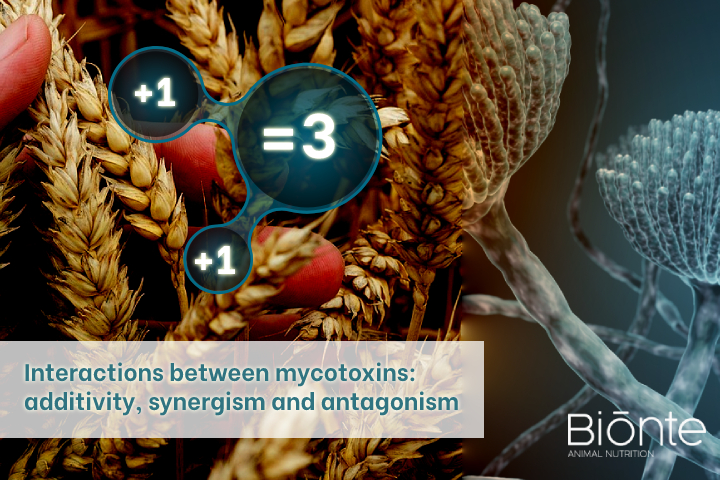| Combination of mycotoxins |
Described effect |
| Deoxynivalenol + Aflatoxin B1 |
It has been described that the presence of both toxins leads to a greater severity of clinical signs in chickens, such as: decreased weight gain, reduced growth rate and anemia. In
pigs, with the combination of these toxins, the animals present to a greater extend vomiting, rejection of feed and reduction of growth rate (Gimeno et al., 2011) . |
| T-2 Toxin + Aflatoxin B1 |
The synergy between aflatoxin and T2 toxin is of great importance in poultry as it has a higher prevalence and severity (Greco et al., 2014) . Studies conducted in chickens found that the effects of T-2 toxin and AFB1 are aggravated when both are present. Animals typically exhibit oral lesions, reduced live weight gain, decreased serological enzyme activity, decreased protein levels, among other symptoms (Gimeno et al., 2011). |
| T-2 Toxin + Ochratoxin A |
The combination between these mycotoxins affects several production parameters in the animals. In chickens, the combined activity of both mycotoxins induces a reduction of
growth rate and a reduction of protein levels. It also alters the nutritional effectiveness. In pigs, the combined contamination of these two mycotoxins significantly reduces live weight gain, as well as decreasing the relative weight of the liver (Gimeno et al., 2011) . |
| T-2 Toxin + Deoxynivalenol |
In chickens, the combined contamination of these mycotoxins substantially alters weight gain. In addition, oral lesions are reported with T-2 toxin, which are further increased with the inclusion of deoxynivalenol (Gimeno et al., 2011) . |
| Diacetoxyscirpenol + Ochratoxin A |
In chickens, there is a notable increase in the relative weight of the liver, gizzard and kidneys. In addition, serious problems of nephropathy and oral lesions are reported
(Gimeno et al., 2011) . |
| Diacetoxyscirpenol + Aflatoxin B1 |
In pigs, it is reported that the combination of both toxins causes an increase in the relative weight of the liver and spleen. It also decreases iron uptake, reduces serum nitrogen levels, and aggravates other pathological disorders (Gimeno et al., 2011) . |
| Fumonisin B1 + Toxin T-2 |
In chickens, it is reported that the combination of these toxins generates mortalities up to 15%. It also causes an increase in the relative weight of the liver and kidneys; the levels of cholesterol also increase (Gimeno et al., 2011) . |
| Deoxynivalenol + Zearalenone |
In pigs, it is reported that the combination of these toxins causes rejection of feed, vomiting and bloody stools. In hens, the combined effect of both toxins causes a reduction in egg production and lesions in the mouth and crop (Gimeno et al., 2011) . |
| Fumonisin B1 + Aflatoxin B1 |
In turkeys, the combination of these toxins significantly reduces the levels of total protein, albumin and cholesterol in serum. In addition, it has been reported that the feed conversion rate altered significantly (Gimeno et al., 2011) . |




